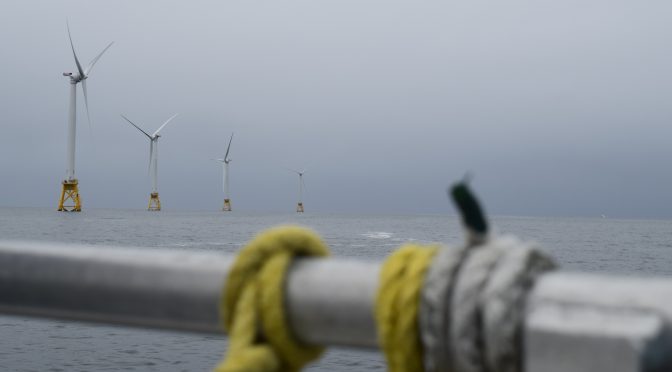More good news from the Department of Energy (DOE) as we hit the midpoint of #AmericanWindWeek. DOE released three new wind energy market reports on Tuesday, including the National Renewable Energy Laboratory’s (NREL) latest annual Offshore Wind Technologies Market Report.
The offshore market report reviews the latest information on the offshore wind market, technology and cost trends in the U.S. and worldwide.
Their findings? Global offshore wind costs are declining, new technologies are being developed, and confidence in the U.S. offshore industry is increasing.
Check out some key highlights of the report:
Offshore wind has arrived in the U.S.
The country’s first commercial offshore wind project – the Block Island Wind Farm – starting operation in December 2016. It’s a 30 megawatt (MW) pilot project in state waters off Block Island, Rhode Island. The project consists of five 6-MW GE Haliade turbines and was developed by Deepwater Wind. It sells electricity to National Grid, supplying both mainland Rhode Island and satisfying all of Block Island’s electricity needs.
Although smaller than offshore projects in other countries, it marks a historic moment in the U.S. offshore wind industry and has helped accelerate interest in the U.S. offshore wind market.
Offshore wind costs and prices have declined across the globe – particularly in Europe
European “strike prices” (winning auction prices for offshore wind bids) have decreased significantly in the past couple years, dropping as low as $65 per megawatt-hour. While many factors affect these auction prices, the recent trend in price declines indicates a reduction in offshore wind costs.
Confidence in the emerging U.S. offshore wind market has increased
Decreasing global costs, continued supply chain development and new state policy commitments have the industry feeling optimistic about the future of American offshore wind power.
In the past year, Massachusetts and New York made commitments to buy 1,600 MW and 2,400 MW of offshore wind energy, respectively, while Maryland recently awarded offshore renewable energy credits to two offshore projects totaling 368 MW.
Recent U.S. offshore lease activities have attracted a diverse group of industry participants, including DONG Energy, Statoil, and Avangrid Renewables.
More offshore wind is on the way
The U.S. offshore wind project development pipeline currently includes over 20 planned projects totaling more than 24,000 MW of potential installed capacity.
That includes 12 projects that have won competitive lease auctions from the Department of Interior’s Bureau of Ocean Energy Management (BOEM), including the Skipjack Wind Farm, South Fork Wind Farm, and Vineyard Wind.
Another five projects have submitted unsolicited applications to BOEM, and five demonstration projects have obtained exclusive development rights to a site from federal or state authorities.
A majority of the nearer-term activity is concentrated in the Atlantic off the Northeast coast, but projects have been proposed off the Southeast coast, in the Pacific (off of California and Hawaii), the Gulf of Mexico, and the Great Lakes.
Offshore wind turbines are getting larger and projects are being developed in deeper waters further from shore
The global offshore wind industry is developing larger and larger turbines – with a push towards turbines between 6 to 8 MW in deeper waters. Larger turbines mean fewer installations and lower maintenance, and thus lower energy costs. The average offshore turbine size increased from 3.4 MW in 2014 to 4.7 MW in 2016, and NREL expects the average turbine size to reach 7 MW for projects installed in 2020.
Floating foundation technology is starting to be developed for projects in deeper waters. There are currently over 20 floating demonstration or pilot-scale projects around the globe, as well as four proposed commercial scale projects planned off Hawaii and California.
NREL’s full report provides a wealth of additional details on the offshore wind market and technology trends. We’re excited to follow the progress of the emerging U.S. offshore wind industry in the years ahead.


